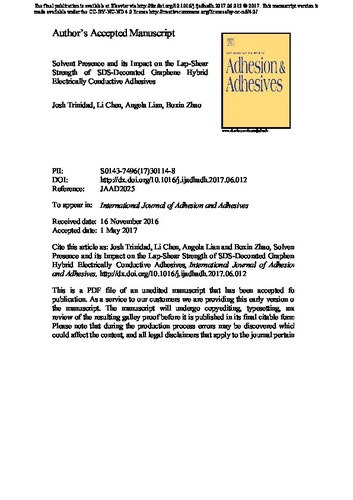| dc.contributor.author | Trinidad, Josh | |
| dc.contributor.author | Chen, Li | |
| dc.contributor.author | Lian, Angela | |
| dc.contributor.author | Zhao, Boxin | |
| dc.date.accessioned | 2017-12-13 16:47:50 (GMT) | |
| dc.date.available | 2017-12-13 16:47:50 (GMT) | |
| dc.date.issued | 2017-10-01 | |
| dc.identifier.uri | http://dx.doi.org/10.1016/j.ijadhadh.2017.06.012 | |
| dc.identifier.uri | http://hdl.handle.net/10012/12707 | |
| dc.description | The final publication is available at Elsevier via http://dx.doi.org/10.1016/j.ijadhadh.2017.06.012 © 2017. This manuscript version is made available under the CC-BY-NC-ND 4.0 license http://creativecommons.org/licenses/by-nc-nd/4.0/ | en |
| dc.description.abstract | The mechanical bonding strength of electrically conductive adhesives (ECAs), as well as the impact of residual solvent on the bonding strength was investigated between a copper clad FR-4 surface and conductive adhesives using Lap-shear testing. Both solvent-free and solvent-assisted formulations with various filler concentrations of silver (Ag) and sodium dodecyl sulfate (SDS)-decorated graphene (Gr(s)) in epoxy matrices were prepared and compared. It was found that the introduction of 0.75wt% Gr(s) in solvent-free formulations increased the Lap-shear strength (LSS), while the combination of ethanol solvent and SDS in solvent-assisted formulations significantly decreased the LSS. In addition, it was found that increasing the Ag content generally lowers the LSS for both the solvent-free and solvent-assisted formulations. By examining the structure and interface of both formulations using optical microscopy, surface profilometry and SEM, we found that the solvent-assisted formulations exhibit more voids at the surface of the paste and more bubble formation throughout the material compared to the solvent-free formulations. Therefore, the significant drops of LSS in solvent-assisted Gr(s)-filled formulations may be attributed to the formation of bubbles at the micron range during the curing process. | en |
| dc.description.sponsorship | Refined Manufacturing Acceleration Process Network (ReMAP Project M4) | en |
| dc.description.sponsorship | Natural Sciences and Engineering Research Council of Canada (NSERC RGPIN-2014-04663) | en |
| dc.language.iso | en | en |
| dc.publisher | Elsevier | en |
| dc.rights | Attribution-NonCommercial-NoDerivatives 4.0 International | * |
| dc.rights.uri | http://creativecommons.org/licenses/by-nc-nd/4.0/ | * |
| dc.subject | Conductive adhesives | en |
| dc.subject | Lap-shear strength | en |
| dc.subject | Solvent | en |
| dc.subject | Surfactant-decorated graphene | en |
| dc.title | Solvent presence and its impact on the lap-shear strength of SDS-decorated graphene hybrid electrically conductive adhesives | en |
| dc.type | Article | en |
| dcterms.bibliographicCitation | Trinidad, J., Chen, L., Lian, A., & Zhao, B. (2017). Solvent presence and its impact on the lap-shear strength of SDS-decorated graphene hybrid electrically conductive adhesives. International Journal of Adhesion and Adhesives, 78(Supplement C), 102–110. https://doi.org/10.1016/j.ijadhadh.2017.06.012 | en |
| uws.contributor.affiliation1 | Faculty of Engineering | en |
| uws.contributor.affiliation2 | Chemical Engineering | en |
| uws.contributor.affiliation2 | Waterloo Institute for Nanotechnology (WIN) | en |
| uws.contributor.affiliation2 | Institute for Polymer Research | en |
| uws.typeOfResource | Text | en |
| uws.typeOfResource | Text | en |
| uws.peerReviewStatus | Reviewed | en |
| uws.scholarLevel | Faculty | en |


